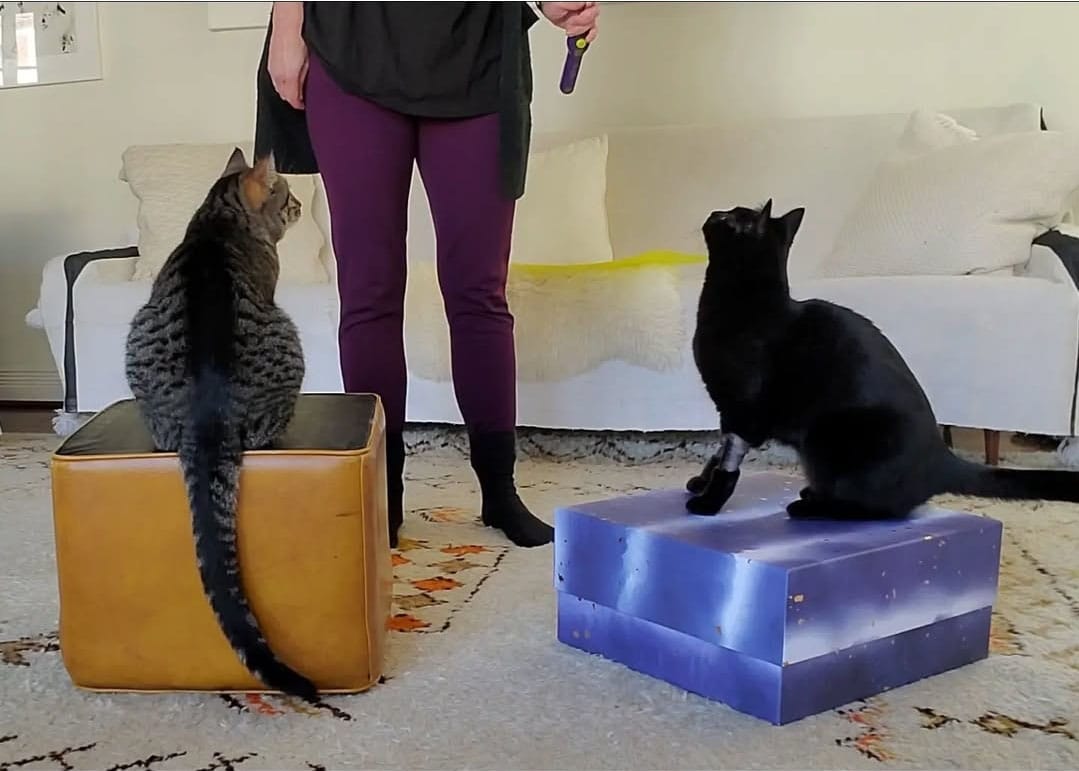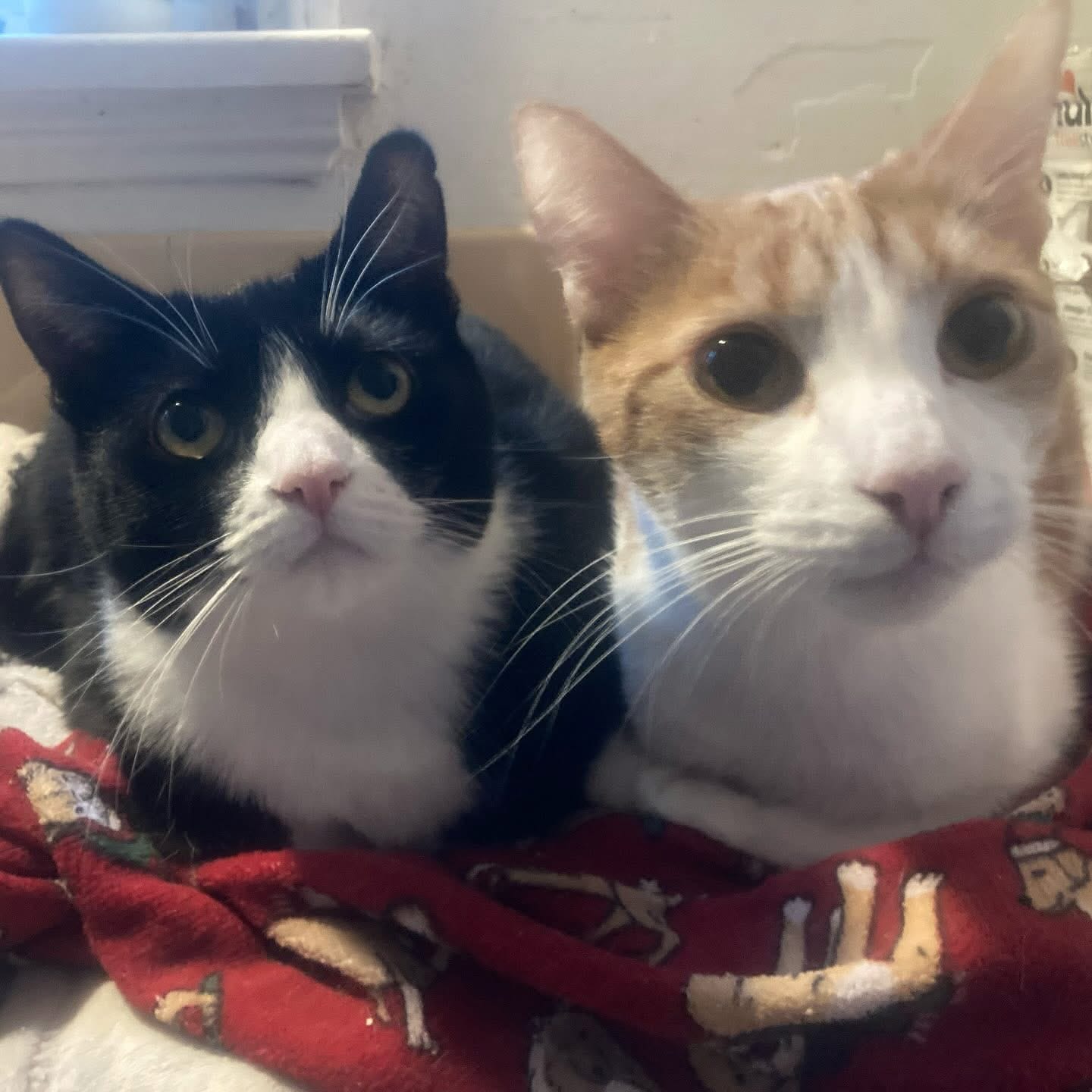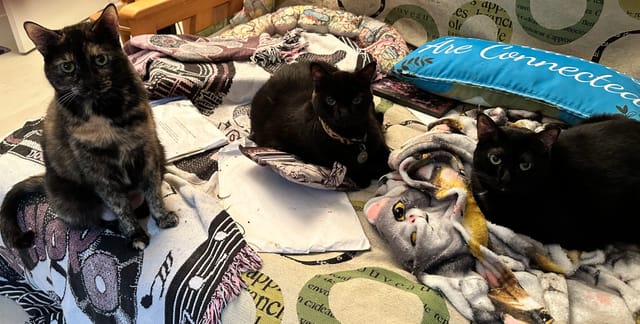Scratch This: Who says you can't train cats?
Hannah McCoy of Hannah's Cat Training sure doesn't.

A lot of years ago, I tried to get my cat to quit clawing my sofa using punishment by spray bottle, distraction to a new behavior and a reward. Rockabye, a beautiful, black medium-hair mongrel, had been given to me by one of my good students, and I figured that aptitude ran in the family. Whenever he’d walk over to the sofa, retractable jackknives at the ready, I’d squirt him with water and then pick him up, take him over to his scratching post, and move his arms over the post in a clawing motion. Then, he’d get a goodie.
Like any churlish classroom manipulator, Rockabye soon would catch my eye, then run a claw down the post, and look at me expectantly. He’d get his treat, and do it again. And again. And again. And the side of my sofa assumed a resemblance to shredded wheat. What had I done wrong?
“You trained your cat to expect a reward when they scratched on the scratching post,” said Hannah McCoy, curriculum chief and instructor at Hannah’s Cat Training in Los Angeles. “You did great by providing him with a scratching post and rewarding him for using it, But giving him a treat every time he did it increased his desire to do it, which is exactly what you were seeing when he went over and scratched just to get the treat!”
Training cats? Seriously? Up, boy — fetch my Crocs? Well, yeah, even Rockabye was trained — or maybe I was — but it wasn’t the training he should have gotten. Can you effectively train a cat?
“No cat is untrainable,” Hannah said. “There are absolutely some cats out there that were just born to learn and perform. These cats are usually very gregarious, well socialized, and highly motivated for food and toy rewards. These cats are so fun to work with, but I also absolutely love the undersocialized, fearful and kind of shut-down cats. It is a different kind of satisfaction to be able to pull them out of their hiding and watch them gain confidence and learn how to be silly.”
Cats behaving badly in the eyes of their holders comprise Hannah’s most frequent requests. To change any unwanted behavior, Hannah said, the best combination is to reward your cat for performing an alternate behavior you do like and couple that by steering them away from the unwanted behavior, Rockabye’s clawing, for instance. Cats, Hannah explained, are biologically driven to claw things and not exhibiting a “bad behavior.” Had I but known Hannah, I’d have followed her counsel to make the desired scratching place desirable and the furniture unattractive to the cat.
Hannah said that I could have purchased special sticky guards, which you leave on the furniture for a month or so. These deter the cat from clawing. Some people find pheromone sprays useful, too. Punishing Rockabye with a squirt bottle for a natural behavior, however, was ineffective.
“As you witnessed firsthand because your cat continued to scratch the couch,” Hannah said.
Yes, cats can be trained if, like Hannah, you understand what makes a cat, a cat and you have patience. Lots of patience.
“It’s not something that the cat learns in days or weeks,” Hannah said. “It’s a behavioral pattern that’s created and ingrained over time, similar to a person who is quitting smoking learning to reach for the pack of gum rather than cigarettes.”
Hannah had been studying behavior modification and applying it to animals for 18 years before she transitioned to mostly cats.
“I worked with everything from rats to elephants,” she said. “The biggest demand was for dogs, but cats are where my heart is. I was able to achieve my goal of transitioning over to primarily cats around 3 years ago, and it has been awesome.”
Cat trainers are a rarity compared with dog trainers, so when someone comes to the end of their wand toy with their cat’s behavior, they’re relieved to find someone like Hannah. She said that she’s been getting an increasing number of requests for help during the past year.
“I think the main reason there are so many more options for dogs is because the world really struggles with the concept that cats can be trained,” she said.
Cats may be perceived as odd or weird, but Hannah has an application for any kitty capriciousness.
“Almost all unwanted behavior is rooted in stress, frustration, fear, undiagnosed or untreated medical issues, understimulation, overstimulation, or because you've been rewarding it,” she said.
Hannah’s faced a few unusual challenges, at least one of which required research. Once, she took on a cat who suddenly had gone into what appeared to be heat years after being spayed.
“When I spoke with the owner on the phone, I thought she must be mistaken,” Hannah said. “The vet had already confirmed that there was absolutely no chance that there was ovarian tissue left after the spay. When I showed up to the session, I was surprised to see that the cat was indeed absolutely in heat. It ended up being a rare tumor that was secreting estrogen. That was crazy!
And once upon a time in Hollywood, or somewhere nearby, Hannah completed a session with a seemingly obsessed Quentin Tarantino fan. Posters from his films were everywhere and a bright-yellow pickup emblazoned with the words “The Pussy Wagon” was parked in the driveway. If you’ve seen “Kill Bill,” you know that it had nothing to do with feline grooming. She finally realized whose house she was at when Tarantino himself came out in his bathrobe drinking coffee.
“I’m very good at training animals, but I can be a bit slow with everything else,” Hannah said.
Most of her sessions, though, have been garden variety cat misbehavior — or unwanted behavior, as Hannah would boop me on the nose to call it. About half the sessions involve cats doing their business outside the litter box, and she also gets a lot for cats who fight with each other and botched introductions to new pets. The remaining 20% is a hodgepodge of biting, fear, teaching tricks and addressing “general mischief.”
“Definitely a majority [of my work] is behavior modification, but I love it when someone just wants to teach their cat cool things and see what they're capable of. It's fun!”
Some people I know would agree. The ones who have succeeded with one-trick-kitties department use some form of behavior modification. My friend Susan Vidor’s cats she’s lived with over the years respond to “requests,” as she calls them, preferring the term over the coldness of command. She taught her cat Tuxedo a dance involving sitting up and waving his front paws up and together repeatedly, and a few of her many others learned to keep her company on the sofa when she came home.
“I turned that natural behavior around so that I could request ‘Tuxedo dance’ or say ‘good sit’ or ‘good uppies’ and reward them with treats or love,” Susan said. “It was simply a way of connecting with my babies, learning what they naturally did, giving it a request name when they naturally did it, then turning it around so I could request they do it.
TNR champion Eva Enrique uses stranger danger as a form of place marking to keep her cats off the furniture. When an unknown person would come to the door and the cats would flee to their hiding place, she’d yell, “Stranger!” Over time, they associated “Stranger!” with hiding, so now, when Eva wants the cats off the sofa, she yells, “Stranger!” and they run and hide. She leaves the treats where they can find them.
My friend Bev is a team member of Helen Sanders CatPAWS. Bev used to teach special education, so she knows about behavioral modification and is a natural for cat training. Her cat Pump is unique, even for a cat, and is an apt pupil. Here’s Pump ringing a desk bell for room service. The bell gets put away when Bev isn’t home so as not to frustrate the cat.
Video courtesy of Tonocats
Bev trained Pump by first putting the treats under the bell. When Pump would touch the bell with her paw, Bev would give her a treat. The cause/effect pairing took about a day to take root. When it did, Bev guided Pump’s paw to make it ding and give the cat a treat. Now, she does it regularly until Bev puts the bell away.
Pump also learned to high-five Bev for a treat and to turn the lights off and on. I’d hate to see her electric bill.
As Hannah said, understanding, consistency and patience will bring results depending on the student’s learning style, the amount of time that you can devote to repetitions and training, and the motivation behind the cat’s behavior, Hannah said.
“Teaching a confident cat who is motivated to earn a reward is going to happen much faster than changing the behavior of a cat who is very fearful,” she said. “Things like stress, lack of consistent training, and allowing the cat to ‘practice’ unwanted behaviors will slow the learning process.”
When Hannah takes on a client, she finds out how long the cat has been exhibiting the behavior and how old the cat is.
“It is not realistic or fair for your 10-year-old cat to suddenly learn overnight that he can't jump on the counters anymore because you woke up and decided that's a new rule,” she said.
As my friend Bev demonstrated with Pump, practice, repetition, learning new patterns and patience are key. The motivation for the behavior must be identified as well, i.e., “what’s in it for the cat?”
“Many times, although we might not like a behavior, we do not realize that the way we are responding to it is actually reinforcing it,” Hannah said. “The first step is to stop accidentally rewarding behaviors we do not like.”
Beans is learning to target, a form of behavioral modification taught to stop an undesired behavior and perform a desired one. "Teaching a cat to follow a target is a very versatile and useful behavior that can be applied to many things," Hannah said. (Video courtesy of Hannah McCoy.)
If you need resources, Hannah’s Cat Training’s web page has a number of them. Hannah also offers phone consultations at a price more affordable than her home consultations. If money is an object or you want to try out techniques yourself first, Cat Daddy Jackson Galaxy's videos offer many cat-behavior topics such as allowing your cat to let you sleep, peeing outside the box, introducing cats and, of course, scratching the furniture. Hannah also recommends Dr. Annie Valuska’s pet-behavior reels.
Yes, you can train a cat, with understanding and acceptance of your own particular feline’s personality and a lot of patience.
“The concept that cats are stoic, aloof, vindictive, petty, unthinking, unfeeling or the low-maintenance alternative to dogs needs to stop,” Hannah said. “They are incredibly smart, observant, emotional, expressive, goofy, curious, and delightfully strange little creatures. They are very misunderstood, and these misconceptions and myths are detrimental to their well-being. We are lucky to share time and space with them. Your cat can be trained — put down the spray bottles and invest in your cat's training, play and environmental enrichment. They deserve it.
Watch Samantha Martin’s The Amazing Acro-Cats touring circus troupe, starring rescue cats from everywhere. If one person could manage what’s in the video below, surely you can keep Cletus’ claws off the couch. Video courtesy of The Amazing Acro-Cats.
Feature photo and attribution have been updated for accuracy.
YOURS DROOLY
With patience and a realistic attitude of not expecting success in a day or two, you can behavior-train your cats. These fosters from Jellicle Cats Rescue Foundation are young enough to adapt and old enough to be out of the kittengarten phase.
Jellicle Cats is a one-person rescue nonprofit run by Brandy Gaunt, the Matron of Jellicle Manor and assisted by her team of kitty-foster footpersons. Check out these two hopefuls as well as the cats and kittens waiting on their website. Meet-and-greets are made through appointment only; apply here.

Socks and Peanut are 2-year-old bonded kitties who have been Jellicles since they were kittens. The fosters don't understand why they haven’t been adopted yet! Socks is a friendly, round tuxie with a lot to say, while her brother-from-another-mother Peanut is lanky, lean, quiet and mischievous. They are both friendly and playful; Socks loves to play with people; Peanut will parkour all over the house and sometimes do a pit stop on someone's lap for a quick hello and scritches before continuing on his way. They sleep together and share their meals. Peanut is not a fan of cats other than Socks. Both are kid friendly and dog tolerant, and they’d bring a lot of laughter to any home.

Spazzy and Shy Ronnie are a bonded pair of 3-year-old siblings who have been waiting patiently for a home of their own since 2022. Rescued from the streets as kittens by foster mom Clara, they’re shy at first but warm up once they get to know you. They love playing with feather wands and springs, and they’ll chase each other with a fun game of keep-away with their favorite toys. Spazzy, the tuxie, is a girly girl with a dainty play style and an affinity for head bonks, while her brother, Shy Ronnie, is more the WWF wrestling type once he's warmed up to his environment. They sleep in a cuddle puddle and are never far from one another. Shy Ronnie is fond of small people, and both cats are dog tolerant. They would be a great addition to a quiet home.
TAIL-WAGGIN' AND NOSE-BOOPIN' EVENTS
Long Beach Animal Care Services at the Eggstravaganza Spring Festival!
Our shelter’s pets and wonderful volunteers will bunny-hop over to Gumbiner Park for a springtime family event. They hope that they will get to be part of your family, too! Stop by to meet them, and learn all about adopting, fostering and volunteering with LBACS! Make sure that you enjoy all the games, egg hunt and photo opps with His Honor the Easter Bunny! Brought to you by District 1 Councilmember Mary Zendejas and the City of Long Beach.
Eggstravaganza Spring Festival takes place Saturday, April 19, noon–2 p.m. at Gumbiner Park, 880 E. Seventh St., Long Beach. Free family event.
Get $50 off a spay/neuter or dental procedure!
Such a deal! Fix Long Beach Pets and Animals offer a nip out of the price of a fix or a dental visit until April 18! Click here for appointments and price lists, and put the code Sherrisays in the notes area. You can also call 562-337-8268 and speak the code when you leave the message.
Fix Long Beach is located at 1749 Magnolia Ave., Long Beach. Hours by appointment only.
Low-cost vaccine clinics
Every pet deserves to be healthy and happy, and so Long Beach Animal Care Services and Community Animal Medicine Project are teaming up every Monday for low-cost vaccine clinics. No appointments; the clinic is open to the first 60 pets. You don’t have to be a resident of Long Beach or LBACS’ contract cities (Signal Hill, Los Alamitos, or Cerritos) to participate. Please bring all past vaccine records. Dogs must be on leashes, and cats must be in carriers.
Clinics are held 10 a.m.–2:30 p.m. on Mondays in LBACS’ parking lot, 7700 E. Spring St., Long Beach, at the entrance to El Dorado Park (no parking fee for shelter visitors. For a list of prices, services and CAMP’s full clinic schedule, please click here.
Need a low-cost veterinarian, information about trapping community cats, places to volunteer, rescues and shelters to adopt from — anything pet relate? Follow this link for resources. Please add your own ideas in the Comments section.
We need your support.
Subcribe to the Watchdog today.
The Long Beach Watchdog is owned by journalists, and paid for by readers like you. If independent, local reporting like the story you just read is important to you, support our work by becoming a subscriber.





